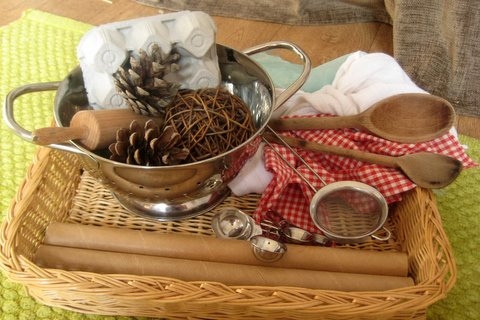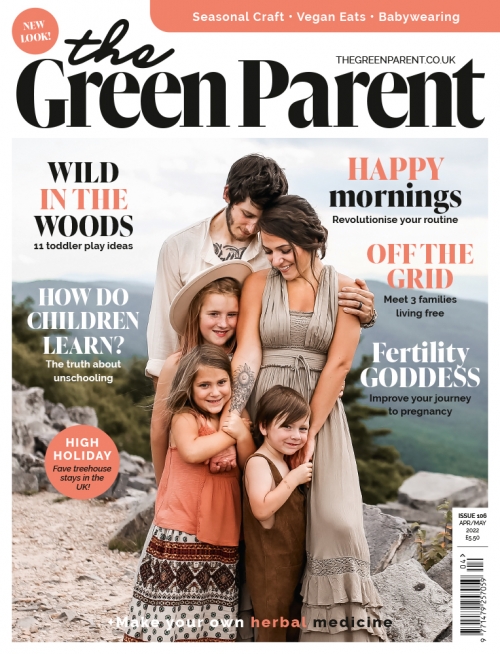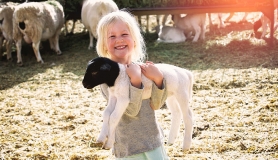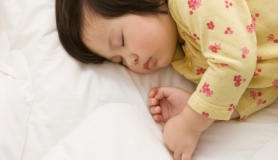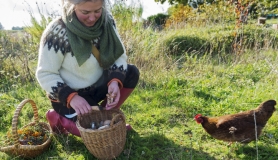As parents and carers we strive to provide the best learning environment for our children, to enable their minds to expand and for them to grow in confidence. Many opportunities are available at little or no cost, in our house, and within nature, to create stimulating experiences which expand our babies’ and toddlers’ growing minds. Lou Threapleton works as a childminder in Bedfordshire, and Katie Duncan is a parent of two young children in South London. Both are searching for a greener way of life and a creative, unhurried way for children to learn: free from pre-determined expectations. One of the approaches that Lou has been using for several years is known as ‘heuristic’ (or as Lou prefers to call it) discovery play. Katie has been experimenting with discovery play at home with her two year old Calum.
Down the ages babies and toddlers have used objects which they found, or were given to amuse themselves, and in so doing have learned about the world they live in. Elinor Goldschmeid, a respected child psychologist, coined the term ‘heuristic play’ and pioneered this concept in the 1980’s. In discovery play we explore a range of natural and man-made non-toy objects with babies and young children. This helps us to discover what they know and can do, as they become deeply involved in choosing objects and exploring them in various ways.
Treasure Basket play for babies
Lou begins discovery play with babies once they are able to sit, and likes to start with a ‘Treasure Basket’. These are available to buy already put together, from companies such Heritage Treasure Baskets, and Lou also collects natural and household objects for herself. So have a go at making one! The first thing you need is a large, open, low-sided basket.
What’s in a Basket?
These baskets are for babies, so the items need to be chosen carefully, so that a baby can explore safely. Lou finds a balance between natural and manmade items that are safe for small fingers, and that a baby can put in his mouth without choking. Just think broadly about choosing objects with contrasting shapes and patterns, textures, scents and sounds. As Lou explains, ”In a typical basket, I might include muslin bags full of herbs from my garden, something shiny, and fabric pouches or small sealed pots with items inside that make a rattling sound. I like to add a wooden spoon, a metal tea strainer, fabric swatches and little boxes or other containers with small treasures inside. The only limit is your own imagination!”
Your role
The most important things are to be with the baby as he explores the basket, and to respond to him, rather than “showing” him how to play. Lou chooses a time when baby is wide-awake, and when she can give undivided attention. “The space should be peacefully quiet. I set up the basket among cushions on the floor and sit opposite my playmate, with the basket between us. That way I can offer smiles of encouragement, and interact with him when he shows that he wants me to join in. I am there to watch and learn about this clever little person, and share what can be a wonderful bonding experience.”
You might like to put together a basket whose objects make up a theme, such as ‘smell’ or ‘shiny’. Lou shared her ‘sounds’ basket with seven-month-old Georgie, who immediately chose the string of shells, which rattled as she lifted them. “This prompted Georgie to make vocal sounds, and repeat the movement as she returned to this item again and again. By making eye contact with me, Georgie was signalling that she wanted me to share the experience. I responded by copying Georgie’s movements and the sounds she was making. This was one of our first steps towards turn taking and conversation.”
Lots of learning
So how do children learn from discovery play? Being able to make choices is important for all children and adults, and the first thing that Georgie had to do was decide, “Which object shall I choose?” Reaching out and handling a shell develops his hand to eye co-ordination, while grasping and lifting it develops his fine manipulative skills, muscle strength and control. This forms the foundation for being able to feed himself, and eventually handle tools or write his name.
As Eva explores a set of wooden napkin rings held together by coarse string, she feels their weight, texture and even temperature, and is processing all this information simultaneously. In her exploration she brings them to her mouth, to explore the taste and texture. Then she taps them together and shakes them. All these interactions allow her to build knowledge about objects, their moving parts, gravity and how, by her own actions, she can make sounds. It is no exaggeration to say that a nine-month-old baby who shakes a film canister full of seeds, and then does the same with another one containing water, will be thinking, “If I shake this one it makes a sound, so I’ll try this one, and listen to find out if it is the same.”
Discovery play sessions like these can lead children to very deep levels of concentration. Learning in this way enables each child to develop their own ideas, and to be creative in how they interact with the world around them. This type of exploratory play is important for the development of a young child’s thinking and language. As children grow, they continue exploring what objects do, and what they can do with objects.
With all discovery play it is important that the collections are not left out all the time, and that items are changed and refreshed: for hygiene reasons, but also to maintain interest.
The Next Step
As babies grow and begin to become mobile, it may be time to move on from the treasure basket, and develop the same principles with collections of similar objects. Lou’s approach remains the same: provide the objects, observe and support and respond when needed. “It’s a good idea to try and limit distractions, so that children can focus solely on the items we have set out. This play needs a large clear floor space. One of my collections, loosely based on the theme of ‘round’ includes a selection of large plastic bottles and their large lids, cardboard tubes, a number of shells, wooden curtain rings, a variety of oval and spherical shaped balls, lengths of ribbon, cones, cotton reels, jam jar lids, tins with different opening lids and perhaps some egg boxes or other item that could be used as a sorting tray.”
Lou has noticed that children go through particular repeating patterns of play, such as filling or emptying containers, so she aims to provide containers such as metal tins with lids, that the objects can be “put in” or sorted and arranged in different ways. “I might prepare for the session by putting some collections ready inside containers, and others in piles or clusters on the floor. If there is more than one child at play I may re-group items as a child moves onto a new interest, so that the objects continue to look appealing for the other children. When two or more children are playing, I make sure there is lots of everything, as children under three years in particular can become guarded over their collections, which can distract them from exploration.“
15-month-old William loves to empty things onto the floor, so Lou provided him with collections that help him explore and learn from this area of interest. Given a collection of shells and clothes pegs, he tipped them all out and ran his fingers over and through the clattering, scattered shells. He giggled, shaking his arms with the thrill. Then he very deliberately added a yellow peg, looked at this arrangement, and shuffled the items again before removing the peg. Lou watched William repeat this play with other items: “I interpreted this as William beginning to explore mathematically, as he experimented with quantity, and the concepts of ‘same’ and ‘different’.“
Try it at home
Start off with collecting jam jar lids, which provide lots of opportunity for discovery and learning. You will need some different tubs or tins that your child could use to put the lids into. Your collection will soon expand if you ask family and friends to help too. Hotels and cafes often serve jam in small jars, and then throw the lids away. By asking staff to collect for us, we are developing their awareness of the value of recycling, as well as increasing the size and variety of our collections! Look for a variety in your collections of objects, and present them on a rug with some containers and sit close by and watch what happens. The wonderful thing about these play resources is that they are “open-ended”. To a child a tin lid can be anything: a plate, a boat, even a snail shell – whatever he can imagine. A plastic toy phone, on the other hand, can only really be a phone. I am not advocating that we remove purpose made toys from our children’s play, merely that we open up their world of creativity and possibility by offering them the opportunity to experience a range of playful experiences.
Katie Duncan, parent to energetic two and a half year old Calum, found it fascinating to see his imagination unravel as he played with a cotton bag full of jam jar lids. “I noticed he really enjoyed describing what he was doing, and explaining his discoveries while playing. The more I just observed, listening only, the more inclined he was to tell me about what the lids were doing. He was able to create many different scenarios with his collection.
“First he told me about each lid and their shapes and sizes. He appeared to be deciding what role each lid was going to play. The biggest lid was being rolled around, while he assessed the others. He explained the connections between each lid saying, “one inside another” and “bigger lid goes on top smaller one”.
Next a bright yellow lid was sailing across the carpet collecting the smaller blue ones and transporting them to a raised island-shaped lid. Flat lids were used to make a bridge and finally the larger one, initially used for rolling, became the top of the bridge, where the “boat of small blue people” lids sailed beneath.
After 20 minutes Calum knocked the bridge down and they packed the lids away. Katie is very clear that discovery play offers huge potential for Calum to learn and grow.
It was clear that whilst playing with these recycled lids, Calum was very aware of the space around him, the connections between each size, and the shape and function of each lid, enabling him to produce a lively ocean scenario. It was exciting to see his imagination come alive as the lids took on their own characters and personalities. “
And when it’s tidy up time
This kind of play may take up to an hour, but once a child begins to lose interest it’s time to see if they would like to help clear everything away. This can be as enjoyable for some children as the main event. In Lou’s home she has drawstring bags with photographic labels showing what goes inside. Some children like to collect things themselves to tidy into their special bag, and the label helps them remember. She also stores objects in baskets or boxes.
“It also gives me a real boost, as we can see just how clever our children are… even before they can speak! This type of feeling is vital for parents’ self-confidence, and can help us to love our babies even more. Now with baby umber two having just arrived, it’s interesting to think of all the possibilities for treasure baskets and bags as a part of our toy collection. What better way for our little ones to learn about the world around them in a safe environment, develop confidence, while recycling!”
The image for this piece is taken from the lovely nurturestore.co.uk

